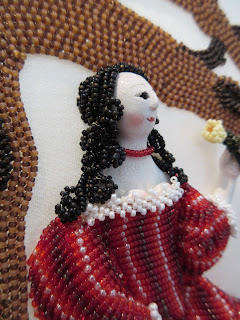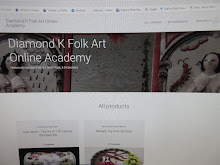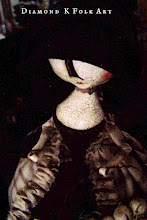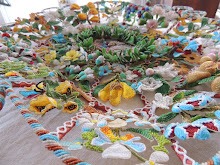Enjoying The Many Steps
I have always been told I have a lot of patience. I'm not so sure...I think I just enjoy the heck out of the process of making things from nothing. A doll from a lump of clay..an embroidered casket from a pile of paper and silks..a cozy quilt from a pile of fabric scraps...or pretty tools from chunks of wood. I enjoy the process of *creating*. Heck, this week I have really been enjoying the process of making lilac jelly, but that's a whole post in itself.
I know I'm not the only one who enjoys the process of making things, and then there's a whole group of folks who have no interest in making anything, but they just like to see how it's done, so I thought I would share my process for making my latest scissor holders in the ETSY shop.
It all starts with a gorgeous piece of wood. For these scissor holders, I chose hard maple so that the turning would be nice and crisp. You can see a piece behind the two scissor holders above. It's first cut into a long block, then I cut the corners off on the table saw so the rough turning doesn't break the cutting heads on my tools.
I drew out the design I wanted and worked with my son at the lathe to get just the right shape. Josh rough-turned the blocks for me.
They were a wonderful maze of cuts and angles...sometimes the wood chipped out or broke. We just went with it and created. After turning, I cut them apart by hand~ LOTS of careful sawing!
Here are three...to the left above is a little dude that broke halfway through turning, so Josh just went with it and I turned it into a candle holder. Once the holders are cut apart, they get sanded and then drilled in the center for the scissors. The holder on the right still has a flush top. I wanted these to gracefully dip down to the hole in the center, so they get carved out, by hand(holder in the middle). Carving on the end grain is extremely difficult~ it took some while, and I had to be very careful to not cut off any of my fingers. Funny story, I did slice a huge chunk out of one of my fingers on the drill press. It's always when you least expect it!
After sanding and sealing the piece, the design is drawn on by hand in pencil. For this particular holder, my design was inspired by a pair of 18th c hand painted silk dress sleeves in the Colonial Williamsburg collections. (The finished piece is shown in the first photo)
Next, I draw the design and add details with a steel tip pen and India ink, just like it was done in the early 19th c. I do not use waterproof pens or Sharpies like other folks. I use drawing ink and a dip pen, that's it.

I usually sign it someplace within the design. This holder is going to be blackwork, inspired by 17th c blackwork embroidery designs, and painted only in black. I love painting in a monochromatic palette. It's a challenge to see how much depth and movement one can make with just shades of a single colour. These are particularly challenging to ink because of the compound angles. In order for ink to flow from a steel tip pen, the little channel through the center of the tip must open with downward pressure. This is done by pulling the tip toward you. The angles on this piece greatly limit the design. For example, on the Williamsburg holder, I was planning on writing on the bottom lip, but ultimately I could not get the ink to flow thru the tip because of the weird angles so drew vines there instead.

Colours are built up over several layers. This is two separate coats of black so far. I paint only with watercolours. The first shading is done on what will become the light parts of the design.
Same flower after 5 more cycles of black and lacquer.
Finally, tiny hints of white are added to pop little details. In watercololurs, all colours are transparent, except white. White is opaque so it really pops and jumps out of the design. love it
I added some faded bands of black to finish it. I wish I had some of the blackwork slate frames & other tools I have painted over the years to photo with it~ these look smashing as a set. It's available in the ETSY store if you are interested in it. I think there are still a couple of needle minders in blackwork left from the group of tools I listed last week.
Happy Stitching!
























